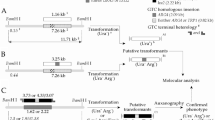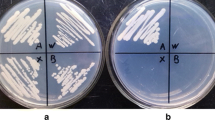Abstract
A disruption cassette has been constructed containing the LEU2 gene flanked by directly repeated sitespecific recombination sites of the yeast plasmid, pSB3, which resembles the 2 μm DNA of Saccharomyces cerevisiae. A disruption constructed by inserting this DNA fragment acquires a Leu+ phenotype, which can be easily removed by expressing the FLP-PSB3 gene encoding the site-specific recombinase of pSB3. A test was made using a Schizosaccharomyces pombe host. The ura4 + gene of S. pombe was replaced with the ura4::LEU2 gene constructed by inserting the disruption cassette into the ura4 + gene. Then, the FLP-pSB3 gene driven by the nmt1 + promoter was introduced into this disruptant. Upon de-repression of the nmt1 promoter by removing thiamine from the medium, the rate of appearance of Leu- was increased. As expected the ura4 + locus underwent a structural change. Thus, the FLP-pSB3 protein and its target site can function adequately in S. pombe.
Similar content being viewed by others
References
Alani E, Cao L, Kleckner N (1987) A method for gene disruption that allows repeated use of URA3 selection in the construction of multiply disrupted yeast strains. Genetics 116:541–545
Birnboim HC, Doly J (1979) A rapid alkaline extraction procedure for screening recombinant plasmid DNA. Nucleic Acids Res 7:1513–1523
Broach JR, Guarascia VR, Jayaram M (1982) Recombination within the yeast 2μ circle is site-specific. Cell 29:227–234
Burkholder PR (1943) Vitamin deficiencies in yeasts. am J Bot 30:206–211
Dale EC, Ow DW (1991) Gene transfer with subsequent removal of the selection gene from the host genome. Proc Natl Acad Sci USA 88:10558–10562
Hoffman CS, Winston F (1987) A ten-minute DNA preparation from yeast efficiently releases autonomous plasmids for transformation of Escherichia coli. Gene 57:267–272
Imura T, Toh-e A (1990) A cis-acting locus needed for stable maintenance of the yeast plasmid pSB3. Agric Biol Chem 54:2239–2246
Ito H, Fukuda Y, Murata K, Kimura A (1983) Transformation of intact yeast cells treated with alkali cations. J Bacteriol 153:163–168
Maundrell K (1990) nmt1 of fission yeast: a highly transcribed gene completely repressed by thiamine. J Biol Chem 265:10857–10864
Miller J (1972) Experiments in molecular genetics. Cold Spring Harbor Laboratory, Cold Spring Harbor, New York
Morrison DA (1977) Transformation in Escherichia coli: cryogenic preservation of competent cells. J Bacteriol 133:349–351
Rothstein RJ (1983) One-step gene disruption in yeast. Methods Enzymol 101:202–211
Southern EM (1975) Detection of specific sequences among DNA fragments separated by gel electrophoresis. J Mol Biol 98:503–517
Toh-e A, Utatsu I (1985) Physical and functional structure of a yeast plasmid, pSB3, isolated from Zygosaccharomyces bisporus. Nucleic Acids Res 13:4267–4283
Author information
Authors and Affiliations
Additional information
Communicated by R. J. Schweyen
Rights and permissions
About this article
Cite this article
Toh-e, A. Construction of a marker gene cassette which is repeatedly usable for gene disruption in yeast. Curr Genet 27, 293–297 (1995). https://doi.org/10.1007/BF00352095
Received:
Issue Date:
DOI: https://doi.org/10.1007/BF00352095




